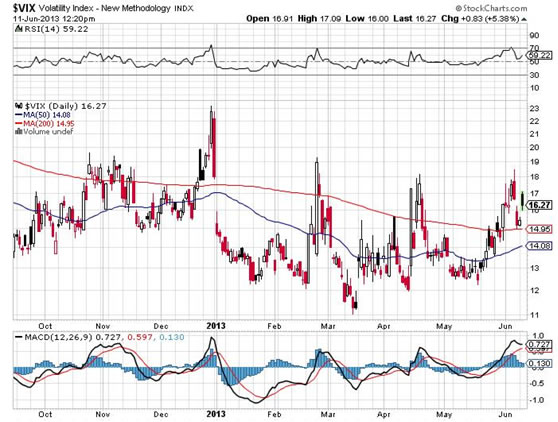Fear Sneaking Back into the Stock Market
Stock-Markets / Stock Markets 2013 Jun 13, 2013 - 02:36 PM GMTBy: DailyGainsLetter
 Moe Zulfiqar writes: In just a matter of a few months, the S&P 500 is up more than 14%. To say the very least, these gains are nothing short of amazing—much better than what investors can get with the long-term U.S. bonds that currently yield less than 3.5%.
Moe Zulfiqar writes: In just a matter of a few months, the S&P 500 is up more than 14%. To say the very least, these gains are nothing short of amazing—much better than what investors can get with the long-term U.S. bonds that currently yield less than 3.5%.
Consider this: on average, in the first five months of this year, the S&P 500 went up by about 2.8% per month (14% divided by five months). Assuming the stock market keeps the same pace, the S&P 500 will gain way more than 30% this year (12 times 2.8%).
Now, one must ask the question: is this sustainable? Can the S&P 500 keep going at this pace?
Since at least 1968, the S&P 500 has gone up more than 30% only three times: in 1975, when it increased by 31.55%; in 1995, when it climbed 34.11%; and in 1997, when it climbed 31.01%. (Source: “History of The S&P 500 Index,” The Standard, last accessed June 11, 2013.) Even with a massive turnaround in the stock market in 2009, the S&P 500 only increased return to 28.04%. (Source: “SPDR S&P 500,” Morning Star, last accessed June 11, 2013.)
Just looking at the economic performance of the U.S. economy when the S&P 500 increased more than 30% in the past, it was exuberant. For example, between 1975 and 1976, the gross domestic product of the U.S. economy grew 5.3%. (Source: “Real Gross Domestic Product, 1 Decimal,” Federal Reserve Bank of St. Louis web site, last accessed June 11, 2013.)
Looking at the economic conditions now, they are not as great. The International Monetary Fund (IMF) expects the U.S. economy to grow at the pace of 1.9% this year and three percent in 2014. (Source, “Policy Actions Improve Prospects for Global Economy,” International Monetary Fund web site, April 16, 2013, last accessed June 12, 2013.)
On top of all this, the unemployment rate is still staggering above 7.5%. Millions of Americans are without a job, while many are working part-time because they are unable to find full-time work for themselves.
Adding to the worries, companies are warning about their earnings in the upcoming quarter. Ninety-three companies on the S&P 500 have provided negative guidance about their corporate earnings in the second quarter of this year, and only 14 expect them to be better—provided there is positive guidance. The ratio of negative to positive guidance for the second quarter is standing at 6.6 currently, the highest since the first quarter of 2001. (Source: Harrison, G., “Earnings Roundup: Second-quarter Earnings Guidance Among the Most Negative on Record,” Thomson Reuters Alpha Now, June 10, 2013.)
You must not forget the troubles from outside, as well. We have the eurozone, which is continuously struggling for growth, and other major emerging economies like China and India are also performing slower than their historical average.
To put all of this into perspective; the gains in the stock market since the beginning of the year are too much to digest. The S&P 500 has gone up too fast in a very short period of time, ahead of economic conditions.
Looking forward, investors may face volatility ahead. Take a look at the chart below of the Chicago Board Options Exchange (CBOE) Volatility Index (VIX), often called the “fear index”:

Chart courtesy of www.StockCharts.com
From mid-May until now, the fear index is up more than 30%. Investors shouldn’t lose sight of the volatility; as a matter of fact, they may be able to profit from it by looking at an exchange-traded note (ETN) like the iPath S&P 500 VIX Short-Term Futures (NYSEArca/VXX). This ETN gives investors exposure to the fear index and profits as volatility increases.
Source: http://www.dailygainsletter.com/stock-market/fear-sneaking-back-into-the-stock-market/1077/
Copyright © 2013 Daily Gains Letter – All Rights Reserved
Bio: The Daily Gains Letter provides independent and unbiased research. Our goal at the Daily Gains Letter is to provide our readership with personal wealth guidance, money management and investment strategies to help our readers make more money from their investments.
Daily Gains Letter Archive |
© 2005-2022 http://www.MarketOracle.co.uk - The Market Oracle is a FREE Daily Financial Markets Analysis & Forecasting online publication.



